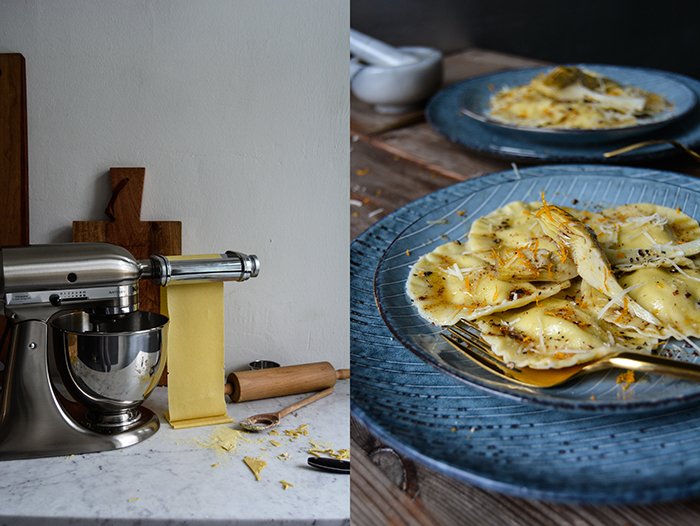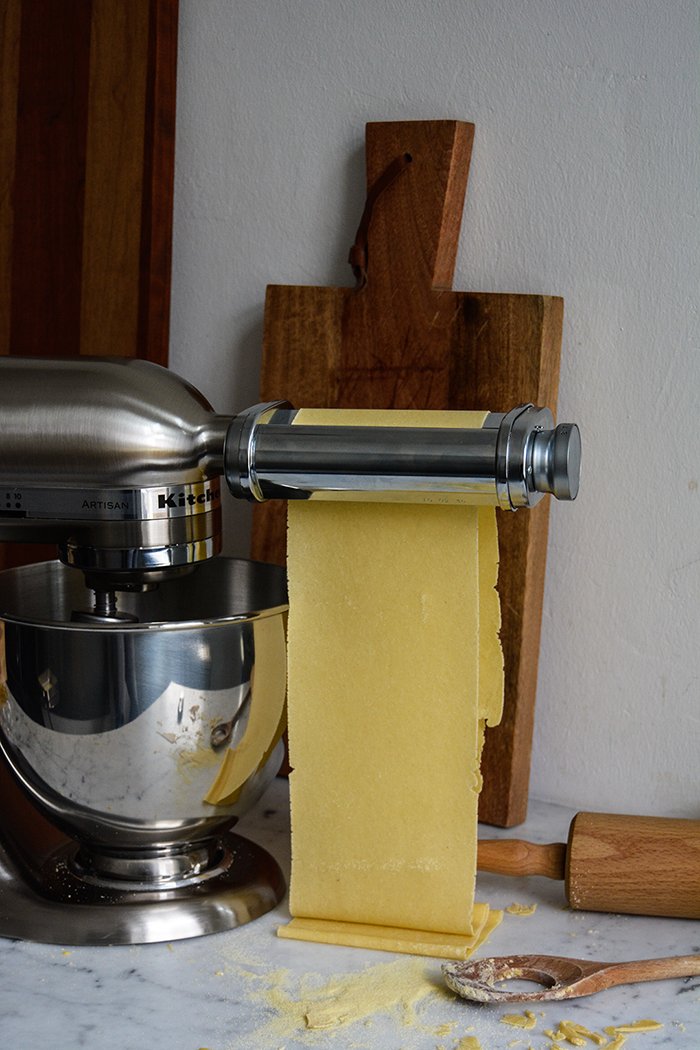Artichoke, Ricotta and Orange Ravioli
If you decide to make your own homemade pasta, be prepared that you'll never be able to eat store bought pasta again (you'll feel less satisfied with it at the very least) - and that you won't feel your arms and abs for a couple days. To knead the dough by hand is necessary and labor-intensive. I had moments when I felt slight doubts about whether the crumbly mixture in front of me would ever turn into a smooth ball, but it worked. I needed all my patience and muscle power to get there, but the result tasted so good that I'd do it all over again (after my muscles got some rest).
My pasta project started last Friday and ended on Saturday afternoon. I first tried a recipe by Sicilian chef Dario Cammarata who only uses plain flour, durum wheat semolina, salt, egg yolks, and olive oil. The result tasted amazing, but getting there was so much harder than what I remembered from when I visited the chef in his kitchen in Frankfurt earlier this year. What seemed so easy in Darios's hands, didn't want to work as smoothly in my own.
Dario taught me that ravioli are best when they are made with egg yolks and not whole eggs. I have no doubt that this is true, the texture is light and perfectly al dente. But to knead my own dough made of 10 egg yolks, flour, and semolina almost made me cry. The mixture was so hard and fragile, I needed an alternative that was less stressful. I still used my egg yolk dough to make a few ravioli, which were perfect, and I made tagliatelle. And these were the best tagliatelle of my life - taste, texture, and thickness were spot on!
Early the next morning I went back to my kitchen. More eggs in the bowl (this time including the egg whites), with a fresh and open mind and a quenchless appetite for fresh pasta, I felt optimistic. Kneading the dough still required some serious muscle power (maybe it's just me, my arms are not the strongest), but it was manageable. And this time I totally enjoyed pulling the thin layers of fresh pasta through my KitchenAid pasta attachment. I needed about two test sheets, but then I was in business. They were so thin that I could see my hand through them.
For my first homemade ravioli, I chose a filling that still allowed me to enjoy the fine taste of the egg pasta. After all this work it didn't feel right to knock it out. The combination of preserved artichokes and fresh ricotta refined with a little orange zest was just right, present, but not overpowering. I served it with melted butter and golden artichoke hearts, briefly seared in the sizzling fat. A little crushed pepper and some more orange zest, and my work was done.
My KitchenAid has three pasta attachments and I'm particularly fond of the tagliatelle cutter. Once I was done with the ravioli, all the shorter pieces and leftover dough went through this attachment and they were perfectly cut into the thinest, tastiest pasta. Cook it al dente and add a knob of butter, freshly grated aromatic hard cheese, and black pepper, and you'll have the best meal ever. Buon appetito!
Artichoke, Ricotta and Orange Ravioli
Homemade ravioli are time and labour-intensive. They are a great starter or main dish for a dinner party, but I recommend preparing them a day in advance to keep it stress free. Freeze them (uncooked) and cook them in boiling salted water just before serving for 4 minutes. I recommend using a pasta machine for this recipe.
Makes 20-24 ravioli / serves 2-4
For the pasta dough
plain flour 150g / 1 cup plus 2 tablespoons
durum wheat semolina 150g / 5 1/4 ounces
fine sea salt 1/4 teaspoon
large organic eggs 3 plus 1 egg yolk
olive oil 1 tablespoon plus 1 teaspoon
water, cold, 1 tablespoon
For the filling
preserved artichoke hearts, drained and squeezed, 160g / 6 ounces
fresh ricotta 125 g/ 4 1/2 ounces
olive oil 1 tablespoon
freshly grated Parmesan 25g / 1 ounce
a pinch of freshly grated orange zest
fine sea salt
ground pepper
For serving
butter 4 tablespoons
preserved artichoke hearts, drained and cut into 6 pieces each, 2
Parmesan
black peppercorns, crushed
a little orange zest
For the pasta dough, in the bowl of a stand mixer fitted with the dough attachment, combine the flour, semolina, and salt. Add the eggs, egg yolk, and olive oil and knead for about 5 minutes (I set it on '4' on my KitchenAid). If it's too dry, add 1 tablespoon of water, but not more. If it's too sticky, add a little semolina and flour. On the counter top or on a stable table, using your hands, continue kneading the dough for about 15 minutes until smooth. It will still be firm. I find it easiest to leave it in the shape of a thick disc for the first 5-7 minutes, punching and kneading it, and scraping the crumbs together. Then I knead it and roll it into a ball (see pictures below). Form a ball, wrap it in cling film, and let it rest in the fridge for 1 hour.
For the filling, purée the artichoke hearts, add to a bowl along with the ricotta, olive oil, Parmesan, orange zest, salt, and pepper. Whisk until smooth and adjust seasoning.
Divide the dough into 4-8 portions (depending on the width and power of your pasta machine). Roll out 1 portion with a rolling pin until it's thin enough to fit into your pasta machine. I started using position '1' on my pasta attachment, using the speed setting '2'. Pull the dough through the pasta machine twice, fold it in the middle, flatten it a little with the rolling pin if necessary, turn it 90°, and pull it through the pasta machine. Continue 2-3 times. Change to a thinner setting (I used '3') and pull the dough through the machine about 3 times, without folding it. Using a knife, straighten the sides of your pasta sheet and cut off excess dough. Continue using the thinner settings of your pasta machine until you can see your hand through the dough (I used '5' and then '6' at the end). If the dough is too sticky, use semolina, but no flour.
Sprinkle the rolled out pasta layer with semolina, fold it gently, and cover with cling film. Continue rolling the remaining dough.
Sprinkle a large baking sheet with semolina. Bring a large pot of generously salted water to the boil.
Lay out a layer of pasta and mark it with circles, using a 7cm / 3" round cutter (or whatever size and shape you prefer). Add a teaspoon of the filling in the middle of each marked circle. Dip your finger in water and wet the rim of the circles. From a second sheet of pasta, cut out circles of the same size, lay on top of the filling, and using your finger, push around the rim (see picture above). Using the cookie cutter, cut out the ravioli and press a little fork all around to seal the rim (see picture below). Transfer the ravioli to the prepared baking sheet.
In batches, cook the ravioli in the simmering water for about 2-3 minutes or until al dente.
To serve the ravioli, in a saucepan, heat the butter over high heat until golden brown, add the artichoke hearts, turn gently, and sauté for 1 minute.
Serve the ravioli sprinkled with the butter, Parmesan, orange zest (optional), and crushed pepper and lay the sautéed artichokes on top.










